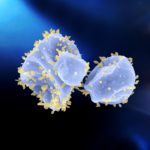Lien vers Pubmed [PMID] – 33782110
Lien DOI – 10.1073/pnas.2022578118
Proc Natl Acad Sci U S A 2021 Apr; 118(15):e2022578118
Archaeal viruses represent one of the most mysterious parts of the global virosphere, with many virus groups sharing no evolutionary relationship to viruses of bacteria or eukaryotes. How these viruses interact with their hosts remains largely unexplored. Here we show that nonlytic lemon-shaped virus STSV2 interferes with the cell cycle control of its host, hyperthermophilic and acidophilic archaeon Sulfolobus islandicus, arresting the cell cycle in the S phase. STSV2 infection leads to transcriptional repression of the cell division machinery, which is homologous to the eukaryotic endosomal sorting complexes required for transport (ESCRT) system. The infected cells grow up to 20-fold larger in size, have 8,000-fold larger volume compared to noninfected cells, and accumulate massive amounts of viral and cellular DNA. Whereas noninfected Sulfolobus cells divide symmetrically by binary fission, the STSV2-infected cells undergo asymmetric division, whereby giant cells release normal-sized cells by budding, resembling the division of budding yeast. Reinfection of the normal-sized cells produces a new generation of giant cells. If the CRISPR-Cas system is present, the giant cells acquire virus-derived spacers and terminate the virus spread, whereas in its absence, the cycle continues, suggesting that CRISPR-Cas is the primary defense system in Sulfolobus against STSV2. Collectively, our results show how an archaeal virus manipulates the cell cycle, transforming the cell into a giant virion-producing factory.



